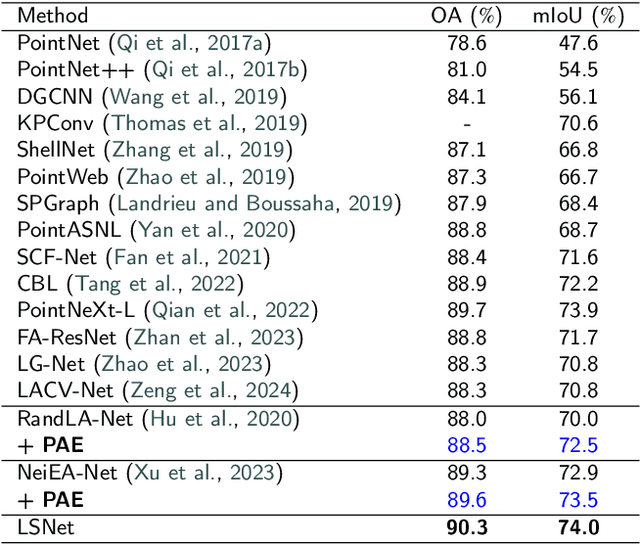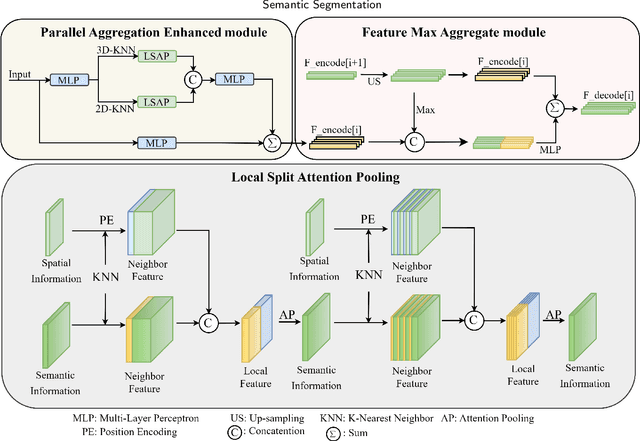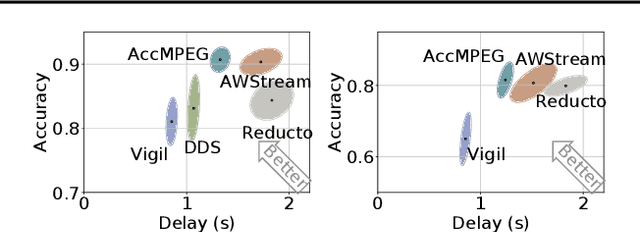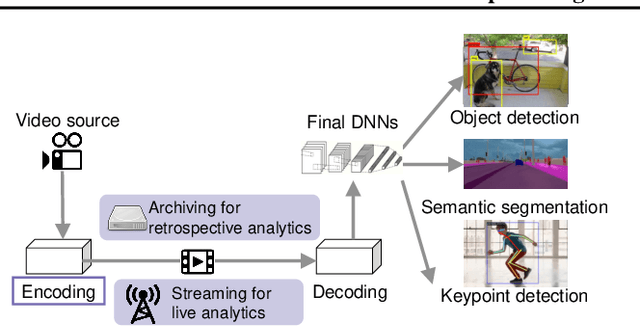Haodong Wang
SLRTP2025 Sign Language Production Challenge: Methodology, Results, and Future Work
Aug 09, 2025Abstract:Sign Language Production (SLP) is the task of generating sign language video from spoken language inputs. The field has seen a range of innovations over the last few years, with the introduction of deep learning-based approaches providing significant improvements in the realism and naturalness of generated outputs. However, the lack of standardized evaluation metrics for SLP approaches hampers meaningful comparisons across different systems. To address this, we introduce the first Sign Language Production Challenge, held as part of the third SLRTP Workshop at CVPR 2025. The competition's aims are to evaluate architectures that translate from spoken language sentences to a sequence of skeleton poses, known as Text-to-Pose (T2P) translation, over a range of metrics. For our evaluation data, we use the RWTH-PHOENIX-Weather-2014T dataset, a German Sign Language - Deutsche Gebardensprache (DGS) weather broadcast dataset. In addition, we curate a custom hidden test set from a similar domain of discourse. This paper presents the challenge design and the winning methodologies. The challenge attracted 33 participants who submitted 231 solutions, with the top-performing team achieving BLEU-1 scores of 31.40 and DTW-MJE of 0.0574. The winning approach utilized a retrieval-based framework and a pre-trained language model. As part of the workshop, we release a standardized evaluation network, including high-quality skeleton extraction-based keypoints establishing a consistent baseline for the SLP field, which will enable future researchers to compare their work against a broader range of methods.
Flow-CDNet: A Novel Network for Detecting Both Slow and Fast Changes in Bitemporal Images
Jul 03, 2025Abstract:Change detection typically involves identifying regions with changes between bitemporal images taken at the same location. Besides significant changes, slow changes in bitemporal images are also important in real-life scenarios. For instance, weak changes often serve as precursors to major hazards in scenarios like slopes, dams, and tailings ponds. Therefore, designing a change detection network that simultaneously detects slow and fast changes presents a novel challenge. In this paper, to address this challenge, we propose a change detection network named Flow-CDNet, consisting of two branches: optical flow branch and binary change detection branch. The first branch utilizes a pyramid structure to extract displacement changes at multiple scales. The second one combines a ResNet-based network with the optical flow branch's output to generate fast change outputs. Subsequently, to supervise and evaluate this new change detection framework, a self-built change detection dataset Flow-Change, a loss function combining binary tversky loss and L2 norm loss, along with a new evaluation metric called FEPE are designed. Quantitative experiments conducted on Flow-Change dataset demonstrated that our approach outperforms the existing methods. Furthermore, ablation experiments verified that the two branches can promote each other to enhance the detection performance.
Aligning Large Language Models with Implicit Preferences from User-Generated Content
Jun 04, 2025Abstract:Learning from preference feedback is essential for aligning large language models (LLMs) with human values and improving the quality of generated responses. However, existing preference learning methods rely heavily on curated data from humans or advanced LLMs, which is costly and difficult to scale. In this work, we present PUGC, a novel framework that leverages implicit human Preferences in unlabeled User-Generated Content (UGC) to generate preference data. Although UGC is not explicitly created to guide LLMs in generating human-preferred responses, it often reflects valuable insights and implicit preferences from its creators that has the potential to address readers' questions. PUGC transforms UGC into user queries and generates responses from the policy model. The UGC is then leveraged as a reference text for response scoring, aligning the model with these implicit preferences. This approach improves the quality of preference data while enabling scalable, domain-specific alignment. Experimental results on Alpaca Eval 2 show that models trained with DPO and PUGC achieve a 9.37% performance improvement over traditional methods, setting a 35.93% state-of-the-art length-controlled win rate using Mistral-7B-Instruct. Further studies highlight gains in reward quality, domain-specific alignment effectiveness, robustness against UGC quality, and theory of mind capabilities. Our code and dataset are available at https://zhaoxuan.info/PUGC.github.io/
D$^{2}$MoE: Dual Routing and Dynamic Scheduling for Efficient On-Device MoE-based LLM Serving
Apr 17, 2025Abstract:The mixture of experts (MoE) model is a sparse variant of large language models (LLMs), designed to hold a better balance between intelligent capability and computational overhead. Despite its benefits, MoE is still too expensive to deploy on resource-constrained edge devices, especially with the demands of on-device inference services. Recent research efforts often apply model compression techniques, such as quantization, pruning and merging, to restrict MoE complexity. Unfortunately, due to their predefined static model optimization strategies, they cannot always achieve the desired quality-overhead trade-off when handling multiple requests, finally degrading the on-device quality of service. These limitations motivate us to propose the D$^2$MoE, an algorithm-system co-design framework that matches diverse task requirements by dynamically allocating the most proper bit-width to each expert. Specifically, inspired by the nested structure of matryoshka dolls, we propose the matryoshka weight quantization (MWQ) to progressively compress expert weights in a bit-nested manner and reduce the required runtime memory. On top of it, we further optimize the I/O-computation pipeline and design a heuristic scheduling algorithm following our hottest-expert-bit-first (HEBF) principle, which maximizes the expert parallelism between I/O and computation queue under constrained memory budgets, thus significantly reducing the idle temporal bubbles waiting for the experts to load. Evaluations on real edge devices show that D$^2$MoE improves the overall inference throughput by up to 1.39$\times$ and reduces the peak memory footprint by up to 53% over the latest on-device inference frameworks, while still preserving comparable serving accuracy as its INT8 counterparts.
IHEval: Evaluating Language Models on Following the Instruction Hierarchy
Feb 12, 2025Abstract:The instruction hierarchy, which establishes a priority order from system messages to user messages, conversation history, and tool outputs, is essential for ensuring consistent and safe behavior in language models (LMs). Despite its importance, this topic receives limited attention, and there is a lack of comprehensive benchmarks for evaluating models' ability to follow the instruction hierarchy. We bridge this gap by introducing IHEval, a novel benchmark comprising 3,538 examples across nine tasks, covering cases where instructions in different priorities either align or conflict. Our evaluation of popular LMs highlights their struggle to recognize instruction priorities. All evaluated models experience a sharp performance decline when facing conflicting instructions, compared to their original instruction-following performance. Moreover, the most competitive open-source model only achieves 48% accuracy in resolving such conflicts. Our results underscore the need for targeted optimization in the future development of LMs.
Shopping MMLU: A Massive Multi-Task Online Shopping Benchmark for Large Language Models
Oct 28, 2024



Abstract:Online shopping is a complex multi-task, few-shot learning problem with a wide and evolving range of entities, relations, and tasks. However, existing models and benchmarks are commonly tailored to specific tasks, falling short of capturing the full complexity of online shopping. Large Language Models (LLMs), with their multi-task and few-shot learning abilities, have the potential to profoundly transform online shopping by alleviating task-specific engineering efforts and by providing users with interactive conversations. Despite the potential, LLMs face unique challenges in online shopping, such as domain-specific concepts, implicit knowledge, and heterogeneous user behaviors. Motivated by the potential and challenges, we propose Shopping MMLU, a diverse multi-task online shopping benchmark derived from real-world Amazon data. Shopping MMLU consists of 57 tasks covering 4 major shopping skills: concept understanding, knowledge reasoning, user behavior alignment, and multi-linguality, and can thus comprehensively evaluate the abilities of LLMs as general shop assistants. With Shopping MMLU, we benchmark over 20 existing LLMs and uncover valuable insights about practices and prospects of building versatile LLM-based shop assistants. Shopping MMLU can be publicly accessed at https://github.com/KL4805/ShoppingMMLU. In addition, with Shopping MMLU, we host a competition in KDD Cup 2024 with over 500 participating teams. The winning solutions and the associated workshop can be accessed at our website https://amazon-kddcup24.github.io/.
Enhanced Semantic Segmentation for Large-Scale and Imbalanced Point Clouds
Sep 21, 2024



Abstract:Semantic segmentation of large-scale point clouds is of significant importance in environment perception and scene understanding. However, point clouds collected from real-world environments are usually imbalanced and small-sized objects are prone to be under-sampled or misclassified due to their low occurrence frequency, thereby reducing the overall accuracy of semantic segmentation. In this study, we propose the Multilateral Cascading Network (MCNet) for large-scale and sample-imbalanced point cloud scenes. To increase the frequency of small-sized objects, we introduce the semantic-weighted sampling module, which incorporates a probability parameter into the collected data group. To facilitate feature learning, we propose a Multilateral Cascading Attention Enhancement (MCAE) module to learn complex local features through multilateral cascading operations and attention mechanisms. To promote feature fusion, we propose a Point Cross Stage Partial (P-CSP) module to combine global and local features, optimizing the integration of valuable feature information across multiple scales. Finally, we introduce the neighborhood voting module to integrate results at the output layer. Our proposed method demonstrates either competitive or superior performance relative to state-of-the-art approaches across three widely recognized benchmark datasets: S3DIS, Toronto3D, and SensatUrban with mIoU scores of 74.0\%, 82.9\% and 64.5\%, respectively. Notably, our work yielded consistent optimal results on the under-sampled semantic categories, thereby demonstrating exceptional performance in the recognition of small-sized objects.
Efficiently Expanding Receptive Fields: Local Split Attention and Parallel Aggregation for Enhanced Large-scale Point Cloud Semantic Segmentation
Sep 03, 2024



Abstract:Expanding the receptive field in a deep learning model for large-scale 3D point cloud segmentation is an effective technique for capturing rich contextual information, which consequently enhances the network's ability to learn meaningful features. However, this often leads to increased computational complexity and risk of overfitting, challenging the efficiency and effectiveness of the learning paradigm. To address these limitations, we propose the Local Split Attention Pooling (LSAP) mechanism to effectively expand the receptive field through a series of local split operations, thus facilitating the acquisition of broader contextual knowledge. Concurrently, it optimizes the computational workload associated with attention-pooling layers to ensure a more streamlined processing workflow. Based on LSAP, a Parallel Aggregation Enhancement (PAE) module is introduced to enable parallel processing of data using both 2D and 3D neighboring information to further enhance contextual representations within the network. In light of the aforementioned designs, we put forth a novel framework, designated as LSNet, for large-scale point cloud semantic segmentation. Extensive evaluations demonstrated the efficacy of seamlessly integrating the proposed PAE module into existing frameworks, yielding significant improvements in mean intersection over union (mIoU) metrics, with a notable increase of up to 11%. Furthermore, LSNet demonstrated superior performance compared to state-of-the-art semantic segmentation networks on three benchmark datasets, including S3DIS, Toronto3D, and SensatUrban. It is noteworthy that our method achieved a substantial speedup of approximately 38.8% compared to those employing similar-sized receptive fields, which serves to highlight both its computational efficiency and practical utility in real-world large-scale scenes.
OneAdapt: Fast Adaptation for Deep Learning Applications via Backpropagation
Oct 03, 2023



Abstract:Deep learning inference on streaming media data, such as object detection in video or LiDAR feeds and text extraction from audio waves, is now ubiquitous. To achieve high inference accuracy, these applications typically require significant network bandwidth to gather high-fidelity data and extensive GPU resources to run deep neural networks (DNNs). While the high demand for network bandwidth and GPU resources could be substantially reduced by optimally adapting the configuration knobs, such as video resolution and frame rate, current adaptation techniques fail to meet three requirements simultaneously: adapt configurations (i) with minimum extra GPU or bandwidth overhead; (ii) to reach near-optimal decisions based on how the data affects the final DNN's accuracy, and (iii) do so for a range of configuration knobs. This paper presents OneAdapt, which meets these requirements by leveraging a gradient-ascent strategy to adapt configuration knobs. The key idea is to embrace DNNs' differentiability to quickly estimate the accuracy's gradient to each configuration knob, called AccGrad. Specifically, OneAdapt estimates AccGrad by multiplying two gradients: InputGrad (i.e. how each configuration knob affects the input to the DNN) and DNNGrad (i.e. how the DNN input affects the DNN inference output). We evaluate OneAdapt across five types of configurations, four analytic tasks, and five types of input data. Compared to state-of-the-art adaptation schemes, OneAdapt cuts bandwidth usage and GPU usage by 15-59% while maintaining comparable accuracy or improves accuracy by 1-5% while using equal or fewer resources.
AccMPEG: Optimizing Video Encoding for Video Analytics
Apr 26, 2022



Abstract:With more videos being recorded by edge sensors (cameras) and analyzed by computer-vision deep neural nets (DNNs), a new breed of video streaming systems has emerged, with the goal to compress and stream videos to remote servers in real time while preserving enough information to allow highly accurate inference by the server-side DNNs. An ideal design of the video streaming system should simultaneously meet three key requirements: (1) low latency of encoding and streaming, (2) high accuracy of server-side DNNs, and (3) low compute overheads on the camera. Unfortunately, despite many recent efforts, such video streaming system has hitherto been elusive, especially when serving advanced vision tasks such as object detection or semantic segmentation. This paper presents AccMPEG, a new video encoding and streaming system that meets all the three requirements. The key is to learn how much the encoding quality at each (16x16) macroblock can influence the server-side DNN accuracy, which we call accuracy gradient. Our insight is that these macroblock-level accuracy gradient can be inferred with sufficient precision by feeding the video frames through a cheap model. AccMPEG provides a suite of techniques that, given a new server-side DNN, can quickly create a cheap model to infer the accuracy gradient on any new frame in near realtime. Our extensive evaluation of AccMPEG on two types of edge devices (one Intel Xeon Silver 4100 CPU or NVIDIA Jetson Nano) and three vision tasks (six recent pre-trained DNNs) shows that AccMPEG (with the same camera-side compute resources) can reduce the end-to-end inference delay by 10-43% without hurting accuracy compared to the state-of-the-art baselines
 Add to Chrome
Add to Chrome Add to Firefox
Add to Firefox Add to Edge
Add to Edge